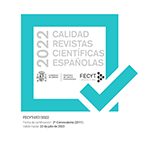Distribution, composition and structure of forest communities with non-native "Sambucus" species in Lithuania
Abstract
In the last two hundred years, forest managers introduced non-native woody species. Such species can negatively impact ecosystems by invading and disrupting communities and ecosystems, changing biodiversity, nutrients and water cycling. The aim of this study was to determine the distribution of Sambucus species in different age Pinus sylvestris forests and the impact of Sambucus sp. on forest communities composition and structure. The data on the characteristics of pine forest stands with Sambucus sp. and dynamics of Sambucus sp. were retrieved from Standwise Forest Inventory and National Forest Inventory databases. Species composition and structure of forest stands with Sambucus nigra, Sambucus racemosa shrub species and natural forests stands were recorded in 43 sample plots. In each plot stand dendrometric characteristics, soil chemical properties and abundance of vascular plant and moss species were recorded in 2016. Data were analysed using ordination and GLM method. Sambucus sp. were mostly spread in fertile, fresh humidity sites in Pinus sylvestris and Picea abies dominated forest stands of 0.7-0.8 stocking level and 41-80 years old. The abundance of Sambucus sp. increased from 1998 to 2015 in all height and different age stands. The highest increase of Sambucus sp. stems was recorded in 2013-2015 in the stands dominated by deciduous Quercus robur and Alnus incana species. Conditionally natural pine forest and pine forest communities with Sambucus racemosa and Sambucus nigra were different in terms of species composition and soil parameters. The highest number of species was recorded in forest communities with Sambucus racemosa, but forests communities with Sambucus nigra were associated with higher amount of soil organic carbon and total nitrogen.Downloads
Article download
License
Mediterranean Botany is an open access journal to promote global exchange knowledge. It facilitates unrestricted access to its contents from the moment of publication in its electronic edition. The originals published are property of the Universidad Complutense and it is mandatory to cite such source in case of total or partial reproduction. All contents are distributed under a Creative Commons License 4.0 (CC BY 4.0). This circumstance must be expressly stated in this way when necessary. You can check the informative version and legal text of the license.














